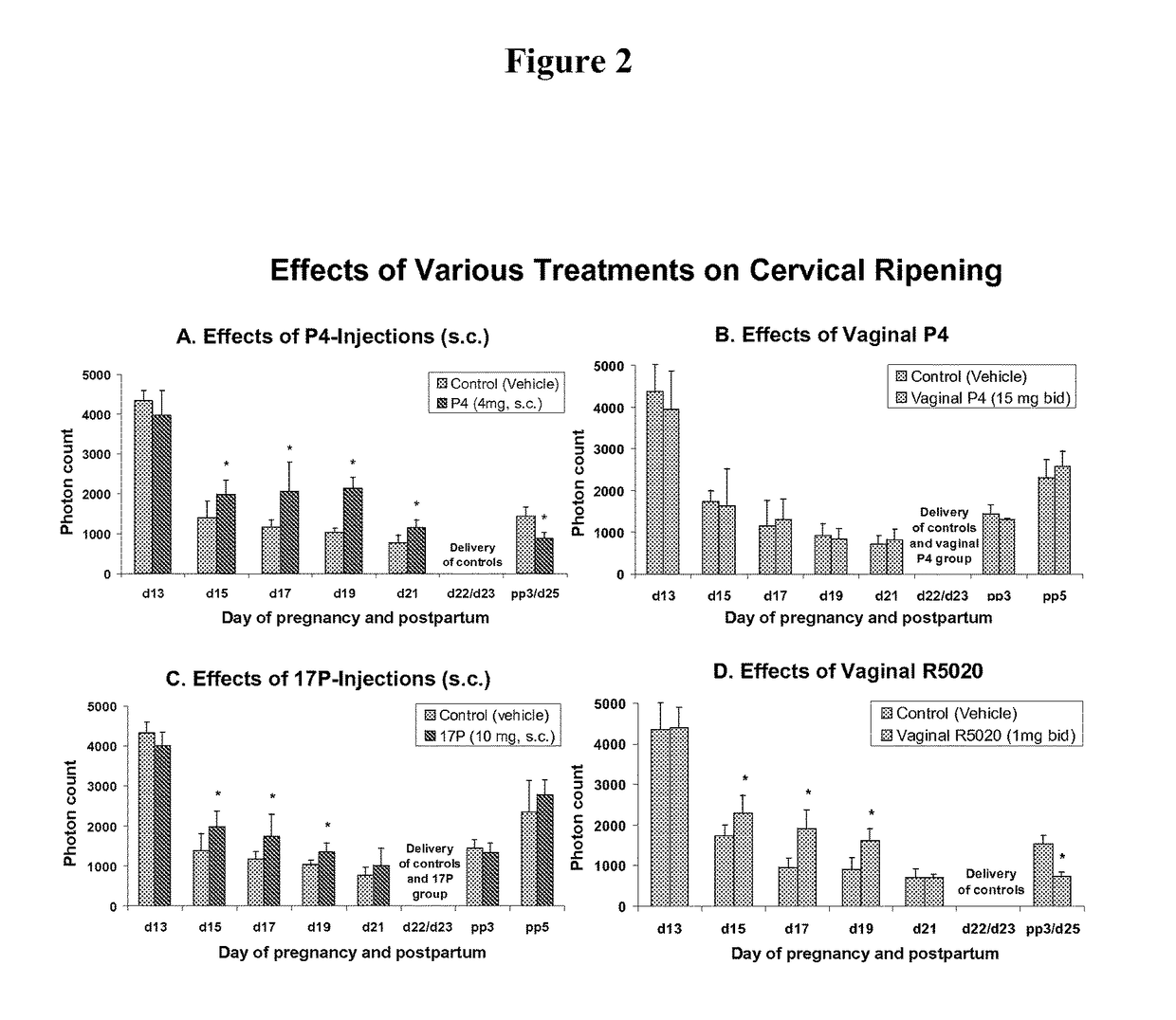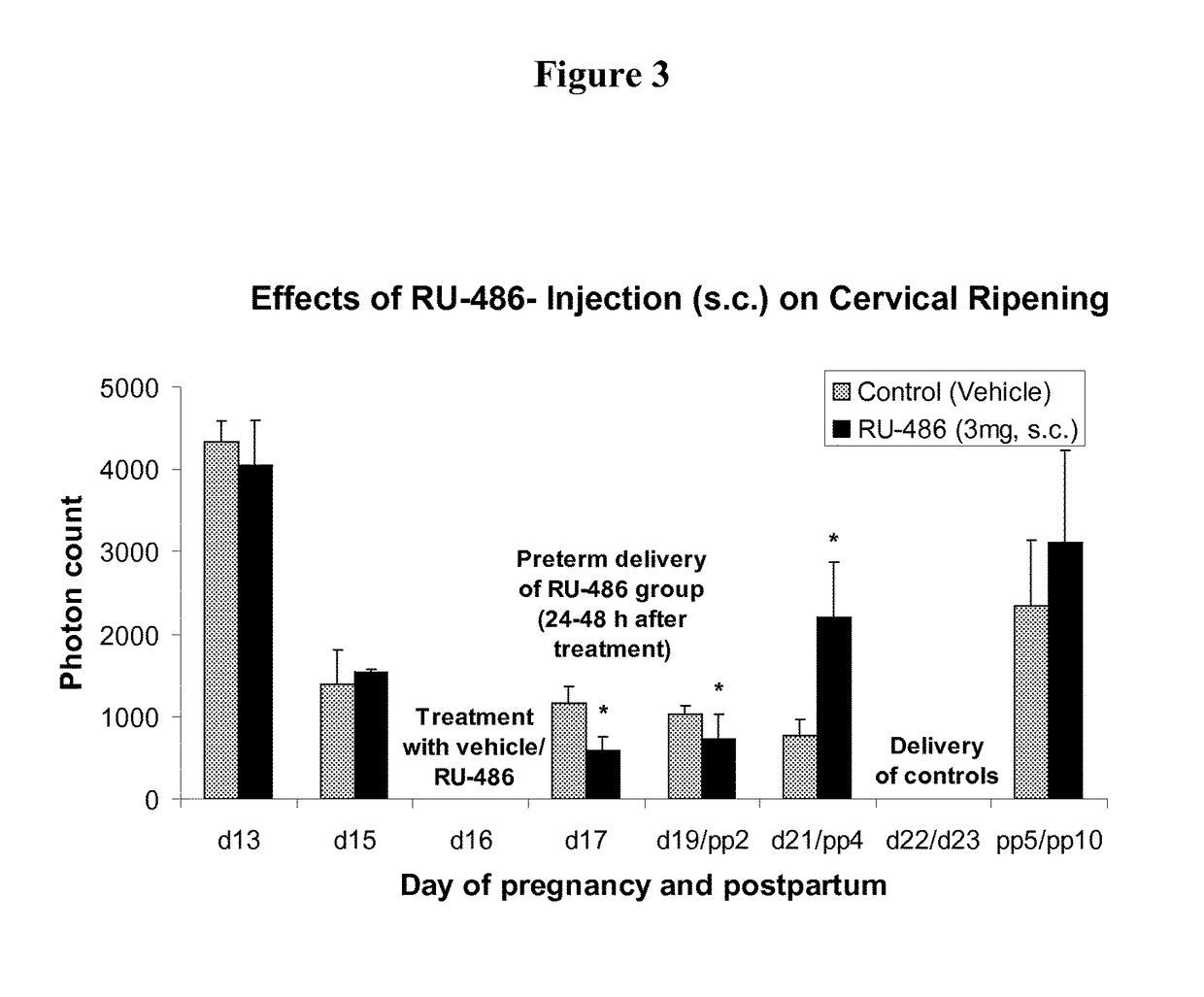Methods for inhibiting preterm labor and uterine contractility disorders and preventing cervical ripening
a technology of uterine contractility and inhibiting uterine contractions, which is applied in the direction of pharmaceutical delivery mechanisms, medical preparations, oil/fat/waxes non-active ingredients, etc., can solve the problems of increasing the cost of neonatal and long-term care of preterm infants, affecting the health of individual families, and affecting the health of preterm infants. , to achieve the effect of inhibiting uterine contractions and cervical ripening, preventing
- Summary
- Abstract
- Description
- Claims
- Application Information
AI Technical Summary
Benefits of technology
Problems solved by technology
Method used
Image
Examples
example 1
Animals
[0103]Nonpregnant and timed-pregnant Sprague-Dawley rats (200-250 g) from Charles-River Laboratories (Wilmington, Mass., USA) were delivered to animal care facilities on day 12 of gestation (day 1 being the day when a sperm plug was observed). The animals were housed separately, with free access to food and water and maintained on a constant 12-hour light-dark cycle. Control pregnant rats were spontaneously delivering on day 22 and 23 of gestation. For the measurements with the collascope the animals were anaesthetized (interperitoneal (i.p). injection) with a combination of xylazine (Gemini, Burns Veterinary Supply Inc, Rockville Center, N.Y., USA) and ketamine HCl (Ketaset; Fort Dodge Laboratories Inc, Fort Dodge, Iowa, USA). The animals were randomly allocated to one of the groups and sacrificed by carbon dioxide inhalation on day 3, 5, 7 and 10 postpartum or on day 25 of pregnancy in the groups with delayed delivery. All procedures were approved by the...
example 2
Effects on Preterm Delivery
LIF in Nonpregnant, Pregnant and Postpartum Rats:
[0110]Measurements of cervical light-induced-fluorescence (LIF) in pregnant, non-treated animals show (FIG. 1) a continuously decreasing photon count throughout pregnancy, reaching lowest values at term, and reversal postpartum. After significant (P0.05) decreases prior to delivery. LIF values progressively increase postpartum (P<0.05).
Effects of Injections of P4 on LIF:
[0111]LIF is significantly (P0.05) between the treatment and the control group and this is similar for all treatment groups mentioned with other treatments (FIGS. 2A-D and 3).
Effects of Vaginal P4 on LIF:
[0112]There are no significant differences (P>0.05) between the vaginal P4 group and vehicle controls at any time in gestation (FIG. 2B) and vaginal P4 failed to inhibit delivery (see FIG. 4B).
Effects of Injections of 17P on LIF:
[0113]LIF is significantly higher (P<0.05) in the 17P treated group (until day 19 only) compared with vehicle contr...
example 3
Applications of Progesterone
[0120]Various studies have raised questions about the ability of P4 and 17P to inhibit recurrent preterm labor and whether these progestins have effects on the cervix to prevent cervical ripening. It is not established which of the progestins and which route of administration is superior and there is controversy in the findings. Existing treatment do not completely prevent preterm birth and in many studies, women were exposed to progestins whether they needed it or not.
[0121]As described herein, injections of P4 show (FIG. 2A) the longest effect on delaying cervical ripening in rats of all compounds used. This treatment inhibited the progression of softening of the cervix in a stage of rat pregnancy, where the physiological P4-levels are still rising.33,34 Thus, higher P4 levels in midgestation of pregnancy in rat has an anti-ripening effect on the cervix. Exogenous P4, administered by subcutaneous injections also decelerate the consequences of the sharp ...
PUM
| Property | Measurement | Unit |
|---|---|---|
| half life | aaaaa | aaaaa |
| length | aaaaa | aaaaa |
| length | aaaaa | aaaaa |
Abstract
Description
Claims
Application Information
 Login to View More
Login to View More - R&D
- Intellectual Property
- Life Sciences
- Materials
- Tech Scout
- Unparalleled Data Quality
- Higher Quality Content
- 60% Fewer Hallucinations
Browse by: Latest US Patents, China's latest patents, Technical Efficacy Thesaurus, Application Domain, Technology Topic, Popular Technical Reports.
© 2025 PatSnap. All rights reserved.Legal|Privacy policy|Modern Slavery Act Transparency Statement|Sitemap|About US| Contact US: help@patsnap.com



